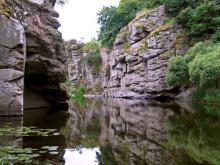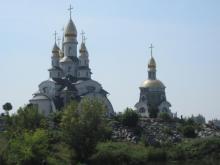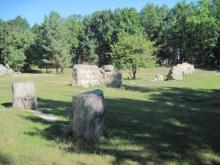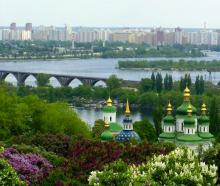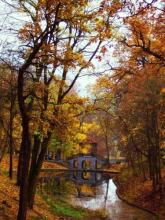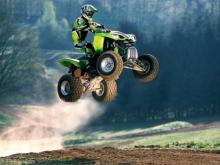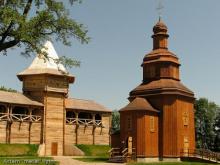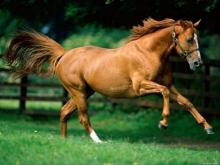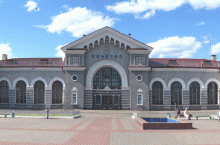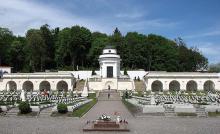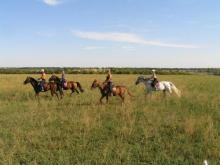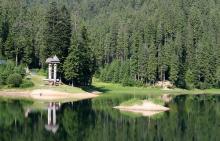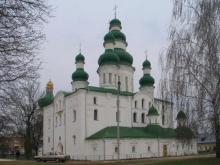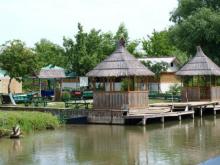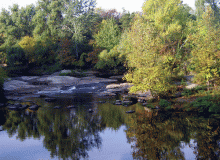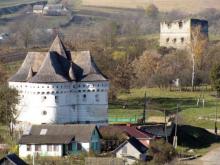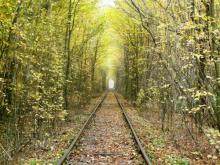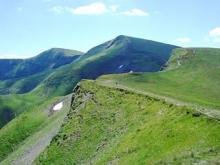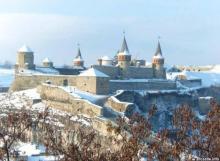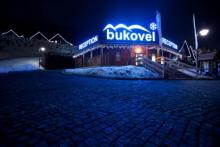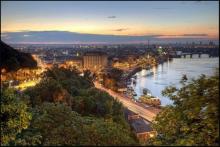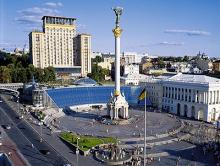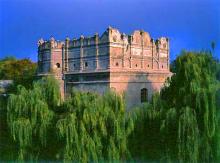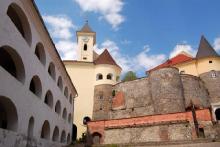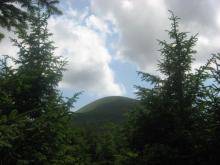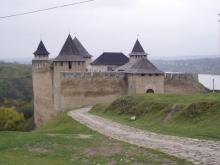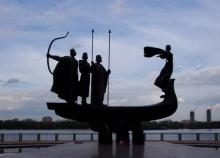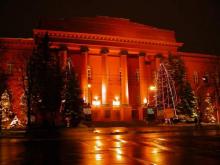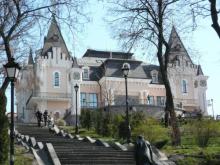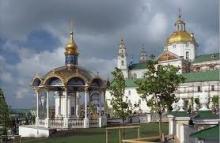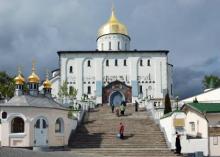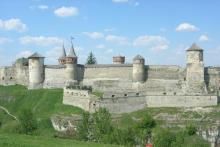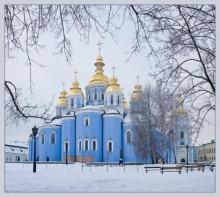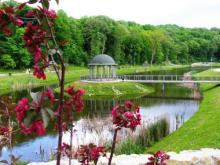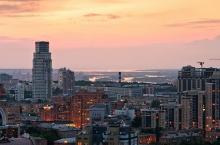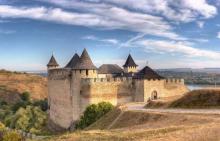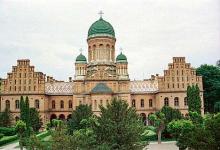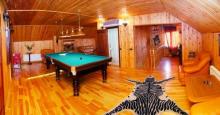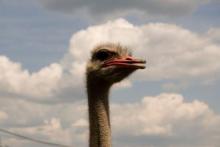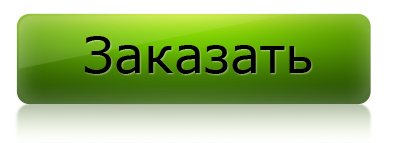Kyiv City tour
Kyiv City tour
Kyiv City tour. Kiev is one of the oldest cities not only in Ukraine, but also in the world. There are many attractions, standing attention of tourists.
During a tour in Kiev, we see the Kiev-Pechersk Lavra, Golden Gate, St. Volodymyr's Cathedral, Botanical Garden, St. Sophia’s Cathedral, Khreschatyk and more. In just one day you will see the main attractions of the capital of Ukraine, get their vision of Kiev, is filled with unforgettable impressions.
Our excursion in Kiev starts from Railway station.
The station building was built in 1932, the author of the project - architector Verbitsky. In 2001, a full reconstruction of the building - from underground utilities and finishing the roof, which is needed to update the 92 tons of copper. Builders themselves say that after such repair roof withstand about 90 years. In the same year in the south station was built a new terminal, called the South. The project to construct new stations on the left bank, in raw and in Darnitsa.
On Syrets is the tallest building in Ukraine. It is 382 meters tall TV tower. Here also is the Babi Yar - a place where, during the Nazi occupation executed a large number of people. In the same area is St. Cyril's Church, which is due to a great distance from the center of Kiev, and the most popular tourist destinations is not very visited place. However, the church is considered one of the oldest and most beautiful in the city. In the mid-12th century, this church was built on the outskirts of the city in Dorogozhychi. It has never been destroyed, but reconstructed in the 17th and 18th centuries. While Cyril Church and took the form which has kept to this day. In addition, the church has attracted attention because the iconostasis for her, and many frescoes says Mikhail Vrubel. Very memorable and very typical for images canonical nature, for example, the image of Our Lady of the iconostasis of St. Cyril's Church.
Continuing the journey through the streets of the Comintern, we get to the old city center. This raises the question of how many years of Kiev. Receive a response to it is not possible - the data on date of the founding of the city is lost. Legend has it that the city bases three brothers, named Kyi, Schek and Khoriv and was their sister Lybid. Kiev could be based BC, or in the 5th century BC - unfortunately, that's for sure no one knows.
When you turn on the boulevard Shevchenko, before us appear the Red Army monument to Nicholas, which was established in 1954. Earlier there was a monument erected in honor to Count Alexander Bobrinsky - organizer and inspirer of the construction of the Kiev railway.
On the left side you can see the St. Vladimir's Cathedral, which was built on the initiative of Metropolitan Filaret and is one of the most majestic and beautiful temples in Kiev. The opening of the temple was dedicated to the 900 anniversary from the date of the Baptism of Russia.
When Emperor Nicholas I approved the construction, started raising funds for this purpose in all parts of the country. In September 1859, the amount of donations reached 100 thousand. In our own factory Lavra million bricks were produced for a donation for the construction of the cathedral. Cathedral got its name thanks to the Baptist of Russia - Prince Vladimir. Architects designed interior and exterior of the church in starovizantiyskom style. These were built in the period of ancient temples of Saint Vladimir and Yaroslav the Wise. Served temple painting mostly Viktor Vasnetsov. Since the early 90's St. Volodymyr's Cathedral is the main church of the UOC-KP.
On the right is the old botanical garden named after academician Fomin.
Turning to Vladimir street, you can see the Theater Square, the Opera and Ballet Theatre, and the Golden Gate - a remarkable monument of defense building belonging to the 9th century. Currently pavilion reconstruction, built in 1973, covers the remains of the ancient gates. At the entrance to the pavilion you can visit a museum works.
On the same side a little further down the street is the ancient Vladimir Sophia Cathedral. This temple is one of the largest and oldest in Kiev. Sophia, or St. Sophia Cathedral, was built in the 11th century by order of Yaroslav the Wise. For a long time it was the main church of the city. Many frescoes and mosaics of the church have survived to the present day. In Soviet times, threatened the destruction of the cathedral, as well as many churches in those years. Sophia Cathedral saved by the fact that it is very closely linked with the history of France. After all, the daughter of Yaroslav the Wise was the wife of the king of France, and was queen of France. Therefore, the French government could prohibit the destruction of the historic monument. Immediately at the entrance to the church is St. Sophia bell tower 75 meters high. Front of the cathedral is St. Sofia's Square, where the monument to Ukrainian military leader and statesman of Bohdan Khmelnytsky.
Ahead is Mikhaylovskaya area and established in the 12th century St. Michael's Cathedral. First Cathedral in Kiev with gilded domes called St. Michael's Cathedral. Also, it is the last, where the mosaic decorations were used - such hard work, which is very expensive. In this place there were graves of several generations of the princes of Kiev. Very long here acted monastery. Many times the St. Michael's Cathedral was exposed by partial destruction and looting. However, he lasted until the 30s of the 20th century and was blown up as a result of the struggle against religious survivals. A substantial part of the mosaic and fresco decoration of the church was taken before the destruction of the cathedral has been preserved in the museums of the USSR. Cathedral was renewed in 1998. Since then, its doors are open to worshipers and visitors.
Soviet authorities planned to build on the site of St. Michael's Cathedral building, which is similar to the Ukrainian Foreign Ministry building placement, it is to the left of the cathedral. And between them, planned to erect a monument to Lenin. In this case, down to the Dnieper was down a broad staircase. And instead of the planned St. Sophia Cathedral is a huge parade ground. And it is not only unrealized project. As was the idea of building a huge six-row road, which was to connect the center of the city to the train station.
At St. Michael's Square is a monument to the greatest ruler of the period of Kievan Rus - Olga. The monument project designed by the sculptor Ivan Kavaleridze. The composition consists of four white marble figure. This is the apostle Andrew, Cyril and Methodius, and Olga. in the 20's of the 20th century monument has been destroyed, the restoration took place only in 1996, which made the students Ivan Kavaleridze. You may be surprised at such a large scale in the data, but it is not a mistake. The sculptor Ivan Kavaleridze was a very fruitful and long life, he died at 91 year of age in 1978.
From St. Michael's Cathedral is heading for Vladimir or Tithe street toward Andrew's Descent. Here, in a rather informal atmosphere, attractive to tourists, there are many souvenir shops, restaurants and cafes. At this point, artists sell their paintings in the open, you can hear the sounds of an old record player, and even buy it, to see and to buy products made by craftsmen and just entertaining to spend their time. Andrew's descent - is the place where the reigning here has a laid-back atmosphere of artistry to friendly conversation.
Andrew's Descent is one of the oldest streets of the capital. There is a monument to Bulgakov, and near his house-museum. There is also the Museum of One Street, the theater-studio Wheel and several galleries. Here is a great architectural and historical monument, St. Andrew's Church, which was built according to the design of architect Rastrelli. You can see also Richard Castle.
On the right side of the street is St. Michael's Cathedral Mikhailovskaya. This is a street-rays, leading to the main street of the capital - Khreschatyk. In ancient times there was situated Valley, crossing ravines in the form of a cross. In the early 19th century, there began to appear the first house, the street was formed, which was called Hreschatoy and status of the main street. Later the street was renamed Khreschatyk, the name it has retained to this day. During the Great Patriotic War Khreshchatyk almost completely destroyed. During the retreat of Soviet troops mined the city center and when Kiev captured German troops, an explosion was heard, do not cease for several days. It was at this time, and were first used by remote radio-controlled mines. After the explosions spread terrible fires, which were burning because of all the buildings that were not destroyed in the explosion.
After the war, the street was restored. Khreschatyk was twice as wide, its width is 75 meters and a length of 1200 meters. On Khreschatyk are three areas: at the beginning of the street is the European area, in the end - Bessarabia Square, and on both sides of the street - Independence Square, which is the main square in the city. On the right side is the hotel and the dome Kozacky Trade Center Globe. Near the dome can be seen unusual monument in love lamps. Here is the arch, which is the patron saint of the city - Archangel Michael.
On the other side stands Khreschatyk Ukraine Hotel, and a monument in honor of the decade of Ukraine's Independence - Column of Independence. The monument was opened three presidents: Kuchma, Putin and Kwasniewski on August 23 in 2001. Column height of 62 meters is made of white marble, on top of which is a bronze female Bereguinya - patroness of Ukraine. Independence Square, lying on both sides of Khreschatyk, is a favorite destination for tourists and residents of the capital. Quite often here hosts various concerts, rallies and other public events.
Next to the hotel is a building of Ukraine Academy of Music, dandelion fountain and some interesting sklpturnyh compositions. You can see also the October Palace of Culture, which was formerly the Institute for young ladies.
Heading to the top of the European area streets can uvidetNatsionalnuyu Philharmonic and the building of the Ukrainian House, which was formerly Lenin Museum. Now there are all kinds of conferences, exhibitions, fairs and other interesting activities. On the right is the hotel Dnipro, built in 1966, and next to the park there are Kreschaty puppet theater and a museum of water. Nearby is the Dynamo Stadium Society, which now bears the name of Valery Lobanovsky. Here is a monument to a great coach. Receive up stadium 18 thousand people.
European area is famous for being here on the hem was second in Europe and Russia's first tram. This event took place on June 14, 1892. This route has ceased to exist in 1982. Turning left here about the Philharmonic Hall can be reached by Vladimir descent, which runs along the Dnieper.
In Kiev, the Dnieper airlifted seven bridges. The northernmost bridge is Moscow. On the right side you can see the beauty of the left bank of the Dnieper, which after the Volga and the Danube River is the third largest river. Its length is 2285 kilometers long and the coast of Kiev from 400 to 1500 meters. On the right side is the very place where the baptism of Prince Vladimir of Kiev. A monument in his honor in 1853, is set on Vladimir Hill. Next is the building of the Kiev port, Church of the Nativity and the funicular. The opening of the cable car in May 1905, and it works to this day. Funicular carriages simultaneously begin their movement and move with the same speed, meeting in the center at the fork and then continue to move.
Moving further through the postal area of the Hem, we reserve the right Trukhanov island - a very famous and very old place to stay Kiev. Hem is the oldest inhabited area of Kiev. These excavations suggest that long before the foundation of Kiev people lived here. The main street is the street name Hem Sagaydachny. Until the early 19th century, the area was a low wooden buildings, often due chgo fires took place here. Last fire occurred due to the vastness of careless child's play with fire in 1811. Fire lasted three days. After the fire on Podol nothing left but smoldering embers. The area appears to us in its current form - it's hem, built after a fire in accordance with the project architect from St. Petersburg, a Scottish-born William Hastie, who had never been in Kiev. He came up with the classic straight streets, but his project of the 19th century for us is still not a monument.
The main area of Podol is Kontraktovaya. In the little square is a monument, which is set to hetman Sagadachnomu, away from it you can see the arch design the arcade, which was built in the early 19th century. On the right you can see the name of the Greek monastery of St. Catherine. Kontraktovaya thousand years ago was called the market place and its nvneshnee name it received only in the late 18th century due to transfer to this place Contract Fair. In Soviet times it was called Red Square.
This place clearly visible Staroknyazheskaya and Andrew Hill. Name Andrew slides was the hill on which the legend in 51 AD visited Andrew - one of the disciples of Christ. Mr. spent here his sermons and during one of them foresaw the formation of a great Christian city. Later the building was carried out Krestovozdvizhenskaya wooden churches, which, as its dilapidation followed one another. In 1753 he published a decree of Empress Catherine II for the construction of St. Andrew Church in accordance with the architect Rastrelli. At present, it is in bad condition, just like St. Cyril's Church, and many other valuable monuments of the city of Kiev. On the right side of the St. Andrew's Church is the National History Museum, also is visible ruins of princely palaces and ancient Tithe church.
With Kontraktova Square and see the Kyiv-Mohyla Academy, founded in 1616 as a fraternal schools for boys. The school was named Kiev-Mohyla Collegium in the 17th century. It was created on the initiative of the Metropolitan of Kiev and Galich Peter Graves, who became its vice-rector and guardian. He made a number of reforms here and brought to the Western Brotherhood school education. Since the school has received the status of the board, and later the academy. In board can learn everything, regardless of age and class restrictions. Here, there was no punishment of students, but there was a condescending attitude to the problems in school because of the difficult financial situation and health. It do not pay students for academic failure. In one class, you can stay on the 2nd, and sometimes in 3 years. Training at the academy lasted 12 years, but can continue and further education, because it was because of higher learning. It taught languages, world history, theology, music writing, literature, philosophy, catechism, arithmetic, rhetoric, and other subjects. Academy existed 150 years, and in the late 18th century, has been closed by Catherine II. Re-opened an academy in 1992 and works to this day, but the course it's another, and learning conditions have also changed.
Very interesting sights in the area are also a monument Podol Skovoroda, Church of Our Lady Pirogoscha, Nicholas Pritisko-functioning church, acting Florovsky convent, Samson fountain. Pritisko Nicholas Church was built in the late 17th century, and its history has never been destroyed. There is also a house of Peter I. In fact, this house belonged to enter Kiev - magistrate and leader of the elected body. Today it is the position of mayor. In 1706, here in Kiev Vojta made its stop Tsar Peter I. Since then, the house and called the house of Peter I.
Leaving the left side of the European Square Kreschaty park, along park road you can drive past the Mariinsky Palace, then to Pechersk District. Before the park instead of the road was a solid mountain, where a break in 1911. It was built based Park Avenue and Central Park, which has three of descent to the Dnieper River in the form of terraces. The length of the park is 10 kilometers, and extends it to the bridge of the Podol Paton. Below left visible Askold's grave. According to legend, on this site - on the outskirts of the city on the banks of the Dnieper - the 9th century rulers were killed Kiev princes Askold and Dir. Committed the murder, Prince Igor and his retainers.
With continued movement to the right branch of the road and see the domes of Lavra monument Motherland mother, who is in the Museum of WWII. The opening of the monument took place in 1981. The height of the monument is 102 meters. At the top of the monument works observation deck, where everyone can climb and enjoy the magnificent view of Kiev. But all this is more to come, and could be seen near the hill where there is a large entertainment center and a monument to Leonid Bykov. Here, the actor appears to us in the form of a fighter pilot - the hero of the film "Go to fight some old people."
Leaving the Park of Glory, can turn out Ivan Mazepa. left is seen a monument in memory of the victims of the Holodomor, killed in the 30-ies. Next on our journey is the Kiev-Pechersk Lavra. This is a great cultural and historical park and ancient spiritual haven Kiev, Ukrainians and citizens of ancient Russia. Kiev-Pechersk Lavra has such a large area and a long history that deserves a tour and a detailed account of it. In short, we note that the Kiev-Pechersk Lavra takes soy story with spelaean monastery mid 11th century. Currently in Upper Lavra is a museum-reserve, many active churches, and in the Lower Lavra - famous monastery and the caves with the relics of saints.
Below the monastery is a museum of the World War Second. We continue our journey through the streets of Mazepa the boulevard of Friendship of Peoples and the street Kikvidze. In this way you can get to the Caves botanical garden named Grishko. Gorgeous picture opens eyes of visitors during the flowering magnolias and tree peonies, this beauty can be seen here at the beginning of May. Many visitors also can enjoy the blooms in this season blooming lilac, which has over 150 species. Also, visit the Caves Botanical Garden, you can see a lot of exotic tropical plants, beautiful roses and wonderful to spend time outdoors.
The slopes of Cave Botanical Garden offers spectacular views of the incumbent Vydubychi Monastery. Going down the steep slopes, you will be able to walk to the monastery, in which are buried Varvara and Bogdan Khanenko. These famous people of Kiev, founded the Museum of Art, named in their honor.
Then you can continue your journey, driving along the boulevard Lesia Ukrainka directly to the center of Kiev. You can devote their attention to inspection of the house with chimeras or Bessarabian market. And you can take the trolley and ride to Podol. For those who want to know the city better, it is better to spend on this activity for several days. In our brief review of the unreached are many wonderful places to various attractions. In addition to historical interest to the attention of tourists spots such as the various monuments of culture, history and architecture, the capital of Ukraine has many modern attractions. One of them is the Kiev Zoo. Age Zoo has long been more than a century. It is home to many a variety of animals, ranging from the Arctic penguins and ending with the representatives of tropical countries. Visitors will enjoy great zoo equipped territory, all drowned in the greenery.
Now, it's the end of our excursion to the wonderful city of Kiev, in which we have tried to present to you the most interesting places of the capital. If you are particularly interested in any place in Kiev, you can read about them in more detail on our website, as well as to personally visit them and see with your own eyes. For you to provide a lot of excursions to the capital of Ukraine, which includes all of the above attractions, and besides them so much more entertaining and interesting.

